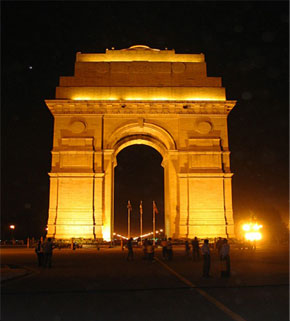Destinations Covered : Delhi-Jaipur-Fatehpur Sikri-Agra-Orchha-Khajuraho-Varanasi-Delhi
Day 01 – ARRIVE DELHI
Late evening: On arrival by your international flight, meet and greet at the airport and transfer to hotel for immediate check in.
Overnight in Delhi
Day 02 – IN DELHI
Full day guided city tour of Old and New Delhi.
Delhi – the capital of India, is a fascinating city with complexities and contradictions, beauty and dynamism, where the past co-exists with the present. Many dynasties ruled from here and the city is rich in the architecture of its monuments. Delhi is not only the present metropolis of India but also a Necropolis. Because of its location, being on the banks of the river Yamuna, many cities have risen and fallen over the last five millenniums.
Morning: Sightseeing tour of Old Delhi. Visit the historic Red Fort – Shah Jehan’s elegant citadel in red sandstone, which was built as an octagon measuring 900m by 550m and surrounded by a 9 meter deep moat which was at its inception fed by the waters of the Yamuna river. The fort is entered from the Lahori Gate and leads to a roofed passage called Chatta Chowk. The Naqqar Khana (drum house) at the end of this passage marks the entrance to the royal enclosure. A spacious lawn leads to the Diwan-i-Am – the pillared Hall of Public Audience, Diwan-i-Khas – the Hall of Private Audience where the emperor met select visitors and the Pearl Mosque built by Shah Jahan’s son, Aurangazeb, the last of the “Great Mughals”. Very near the Fort is the Jama Masjid (Friday Mosque), India’s largest mosque, also built by Shah Jahan. Take an interesting rickshaw ride through the famous bazaars of Chandni Chowk, which is adjacent to both the Fort and the Mosque. Time permitting also visit Raj Ghat – the memorial to Mahatma Gandhi.
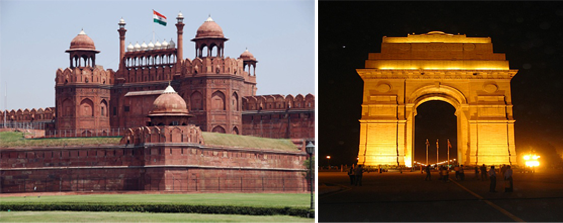
Afternoon: Sightseeing tour of New Delhi. Visit the Qutab Minar, a Tower of Victory that was built in the 12th century by Qutbuddin Aibak. Within its spacious courtyard stands the Iron Pillar, which dates back to the 4th century AD and bears a Sanskrit inscription in the Gupta style. The pillar has puzzled scientists, as its iron has not rusted in all these centuries. The tomb of Humayun – the magnificent structure in red sandstone and white marble is one of the finest examples of the garden tomb, and a precursor to the Taj Mahal. Its proportionate spaces, double dome and refined elegance are characteristic of Mughal architecture. Also visit India Gate, the memorial of the First World War and the road that leads from there to Rashtrapathi Bhawan – the residence of the President of India which is flanked by the houses of Parliament and the Government Secretariat buildings.
Overnight in Delhi
Day 03 – DELHI / JAIPUR
Morning: Drive to Jaipur (260 kms/06hrs) and on arrival, assistance at the time of check in at the hotel. Rest of the day for independent activities.
Overnight in Jaipur
Day 04 – IN JAIPUR
Morning: Guided excursion to Amer Fort with elephant ride. Afternoon: Guided city tour of Jaipur.
Jaipur – the capital of Rajasthan, is colour washed pink – the colour associated with hospitality in Rajput culture. This Pink City of fairy tale palaces, rugged fortresses perched on barren hills and broad avenues are picturesque. The first planned city of its time, a formidable wall encircles Jaipur.
Morning: Excursion to Amber Fort. Drive past by Hawa Mahal, known popularly as the Palace of Winds, is a facade built for the Ladies of the Royal household in the 19th century. The Amber Fort, the capital of the erstwhile State of Jaipur until 1728 is perched on a hill. It has halls of Public and Private audience, a Sheesh Mahal (hall of mirrors) various marble palaces which are marvelous examples of ancient Rajput architecture. The Temple of Amba (Mother Goddess), the patron deity of the Royal family is at the entrance to the palace. Ride an elephant to ascend the hill on which the Fort is situated.
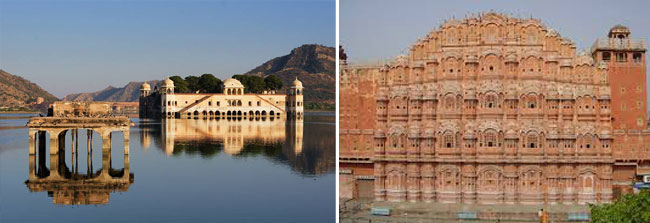
Afternoon: City tour of Jaipur. Visit the City Palace – the former royal residence built in a blend of the Rajasthani and Mughal styles which houses a museum with a superb collection of Rajasthani costumes and armoury of the Mughals and Rajputs, including swords of different shapes and sizes with ornate handles.
It has an art gallery with an excellent collection of miniature paintings, carpets, royal paraphernalia and rare astronomical works in Arabic, Persian, Latin and Sanskrit. Also visit the Jantar Mantar – an astrological and astronomical Observatory built by Maharaja Jai Singh in 18th century, which is remarkable for its accuracy even at the present times.
Overnight in Jaipur
Day 05 – JAIPUR / FATEHPUR SIKRI / AGRA
Morning: Drive to Agra (235 kms/05 hrs) enroute visit Fatehpur Sikri, the deserted city. On arrival in Agra check in at hotel. Rest of the day free.
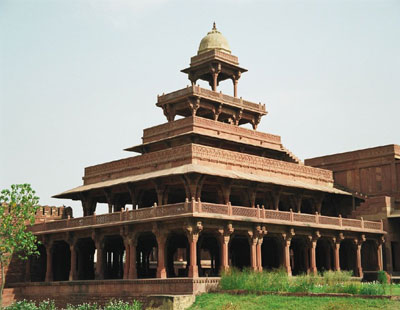
Fatehpur Sikri – This exquisite city built by Akbar the Great in 1569, in red sandstone, with its forts, palaces and mosques was abandoned 14 years after its creation due to political reasons. The Diwan-i-am – a vast courtyard in which the emperor gave daily public audience; Diwan-i-khas – a large quadrangle which contained all the major functions of the Palace, Pachisi court, the Emperors private living quarter, Jodha Bhai’s Palace, Mariam’s Palace, Birbal’s Palace, Hawa Mahal and Panch Mahal are some of the important buildings of this residential complex. The Friday Mosque and the exquisite tomb of Sheik Salim Chisti are in the religious grounds set aside in a separate enclosure adjacent to the secular buildings.
Overnight in Agra
Day 06 – IN AGRA
Early Morning: Guided visit to Taj Mahal at sun rise. After breakfast, visit Agra Fort and Itmad-ud-Daula. Afternoon: Free for independent activities.
Agra is famous as the home to one of the Seven Wonders of the World – the Taj Mahal. The architectural splendour of the mausoleums, the fort and the palaces in Agra is a vivid reminder of the opulence of the legendary Mughal Empire. Agra was their capital for nearly a hundred years from 1564. A pleasant town, with a comparatively easy pace, Agra is known for its superb inlay work on marble and soapstone by artisans who are hereditary crafts persons. The city is also famous for its carpets, gold thread embroidery and leather shoes.
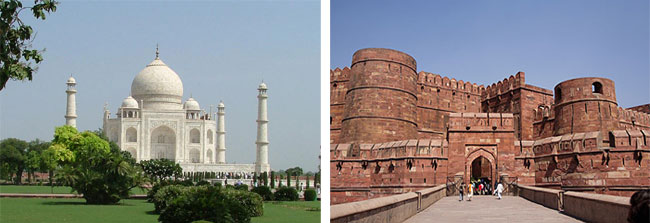
Visit the Agra Fort, built by three Mughal Emperors starting from Akbar the Great in 1565 AD, which is a masterpiece of design and construction. Within the fort are a number of exquisite buildings including the Moti Masjid, Jahangir’s Palace, Khaas Mahal and the Sheesh Mahal, Diwane-i-Am, Diwane-i-Khas and Musamman Burj, where Emperor Shah Jahan, the fifth Mughal Emperor, died a prisoner. Later visit the Taj Mahal – the inimitable poem in white marble. Built over a period of 22 years, by the Mughal Emperor Shah Jahan in 1630, for his Queen Mumtaz Mahal to enshrine her mortal remains, it is one of the seven modern wonders of the World. [The Taj is closed on Mondays]
Itmad-Ud-Daulaha’s tomb, was built by Empress Noor Jahan in memory of her father, Ghias-ud-din Beg in 1622-25 AD. This ornate tomb is considered a precursor of the Taj Mahal
Overnight in Agra
Day 07 – AGRA / JHANSI / ORCHHA / KHAJURAHO
Early Morning: Assistance and transfer to train station in time to board Shatabdi Express at 0810 hrs to Jhansi. On arrival in Jhansi at 1045 hrs, assistance at train station and drive to Khajuraho (185 kms / 4 hrs) enroute visit Ochhan. On arrival in Khajuraho, check in at hotel.
Founded in the 16th century by the Bundela Rajput chieftain Rudra Pratap, Orchha’s grandeur has been captured in stone, the palaces and temples retain much of their pristine perfection.
Jehangir Mahal has built by Raja Bir Singh Ju Deo in the 17th century to commemorate the visit of Emperor Jehangir to Orchha. Its strong lines are counterbalanced by delicate chhatries and trelliswork, the whole conveying an effect of extraordinary richness. Raj Mahal Palace with its plain exteriors, crowned by chhatris, give way to interiors with exquisite murals, boldly colourful, on a variety of religious themes. Rai Praveen Mahal – the palace built for the beautiful paramour of Raja Indramani. It is a low, two storeyed brick structure, designed to match the height of the trees in the surrounding, beautifully landscaped gardens of Anand Mahal, with its octagonal flower beds and elaborate water supply system. Skillfully carved niches allow light into the Mahal, which has a main hall and smaller chamber. Ram Raj Temple – the palace-turned temple with its soaring spires and palatial architecture – is one of the most unusual in India; also are the Chaturbhuj temple and the Laxminarayan temple
Overnight in Khajuraho
Day 08 – KHAJURAHO / VARANASI
Morning: Guided visit to the world famous Erotic temples of Khajuraho. Afternoon: Assistance and transfer to airport in time to connect flight to Varanasi. On arrival in Varanasi, assistance at airport and transfer to hotel. Evening: Attend the evening ceremony on the banks of river Ganges.
Khajuraho – Created by the Chandela kings around 925 AD, Khajuraho emerged when the west was still finding its place in the Sun. The temples are a spectacular feat of architectural excellence, carved with the roughest of tools, all within the span of a hundred years. 85 temples in all portrayed the civilisation of the times’ zest for life, they portray spirituality, love, music, and dance hunting and feasting. Today, 22 temples survive. Khajuraho has achieved fame for he sensual appeal of the erotic sculptures. But, these form only part of the wealth of the site, which depicts everyday life of the people and the court in the 10th and 11th centuries.
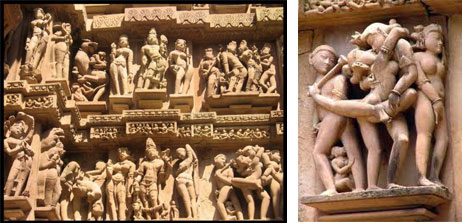
Architecturally the temples have some unique features. They stand on high platforms and do not have customary enclosure. Each temple has a large number of spires in ascending order representing man’s aspirations towards spiritual goals. The sculptures describe the moments of truth, amazement and bliss in which one forgets everything and surrenders completely to spiritual emotion. And this wonder is the elusive theme of the temples at Khajuraho.
Visit the Kandariya Mahadeo temple, largest of the Western group of temple, is dedicated to Shiva. The main shrine is exquisitely carved and features, in delicate detail, gods, goddesses, celestial maidens and lovers. Also visit the Chausat Yogini temple dedicated to Kali and Chitragupta temple dedicated to the sun god Surya. The Parsvanath temple of the Eastern group is the group’s largest Jain temple. The themes depict, in charming detail, everyday activity. Also visit the Duladeo temple dedicated to Shiva and the Chaturbhuj temple of the Southern group.
Overnight in Varanasi
Day 09 – IN VARANASI
Early Morning: Guided boat ride in Ganges at dawnhttp://amicusdesign.com.php5-20.dfw1-1.websitetestlink.com/skyjettours/wp-admin/admin.php?page=wpcf7-integration. Later walking tour of Old city. Afternoon: Guided excursion to Sarnath, where Lord Buddha gave his first sermon after attaining enlightenment.
Varanasi is one of India’s most important pilgrimage sites and the holiest of holy cities for Hindus. Known also as Kashi and Benaras, Varanasi is one of the world’s oldest living cities, and has been a centre of learning and culture for well over 2000 years. Boat ride at dawn down India’s most sacred river, The Ganges. Sun rise at the holy river is a truly tranquil and breath taking sight with pilgrims standing waist deep in water, praying to the rising Sun. Past these bathing ghats, see the “burning ghats” where the Hindus cremate their dead. This is done with great religious fervour, which makes for a moving experience. The Benaras Hindu University founded in 1916 and its famous Museum Bharat Kala Bhavan that houses one of the finest collection of Mughal miniature paintings and brocade textiles. The Bharat Mata and Durga Temple and see the famous Vishwanath temple with its spires covered with gold dedicated to Shiva, the presiding deity of the city.

Sarnath – the place where the Buddha turned the Wheel of Law and delivered His First Sermon. See the Chowkandi and Dhamek Stupas, the ruins of 9th and 10th century monasteries and temples, the temple built by the Mahabodhi Society in 1931, and the Tibetan Temple. Visit the famous Sarnath Museum (closed on Fridays].
Overnight in Varanasi
Day 10 – VARANASI / DELHI
Morning: Assistance and transfer to airport in time to connect flight to Delhi. On arrival in Delhi, assistance at airport and transfer to hotel. Evening: After a farewell dinner at an Indian Specialty Restaurant
Day 11 – DELHI / DEPART
Check out of hotel at 1200 hrs. Rest of the day free for last minute packing / shopping. Later transfer to international airport in time to connect your onward flight home…..
End of the tour

